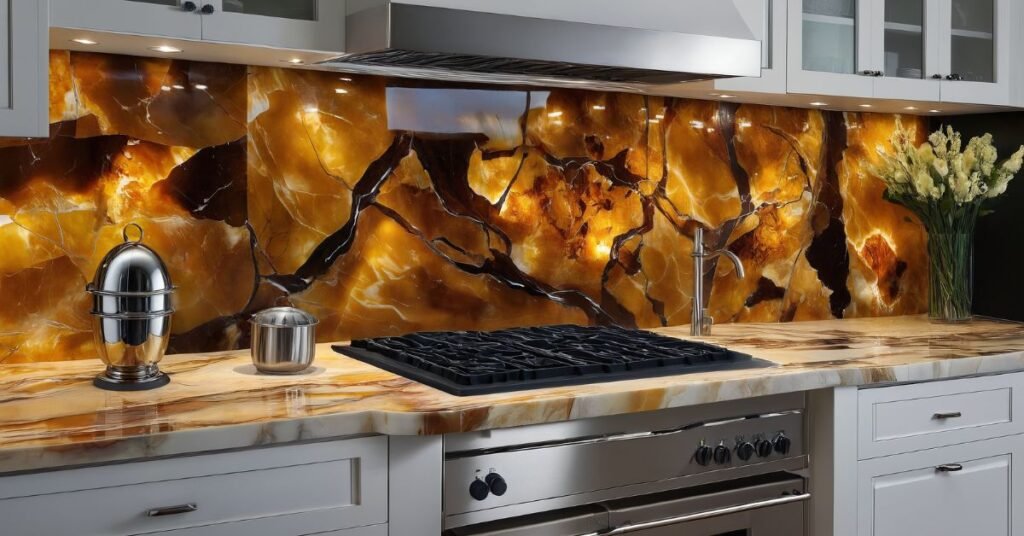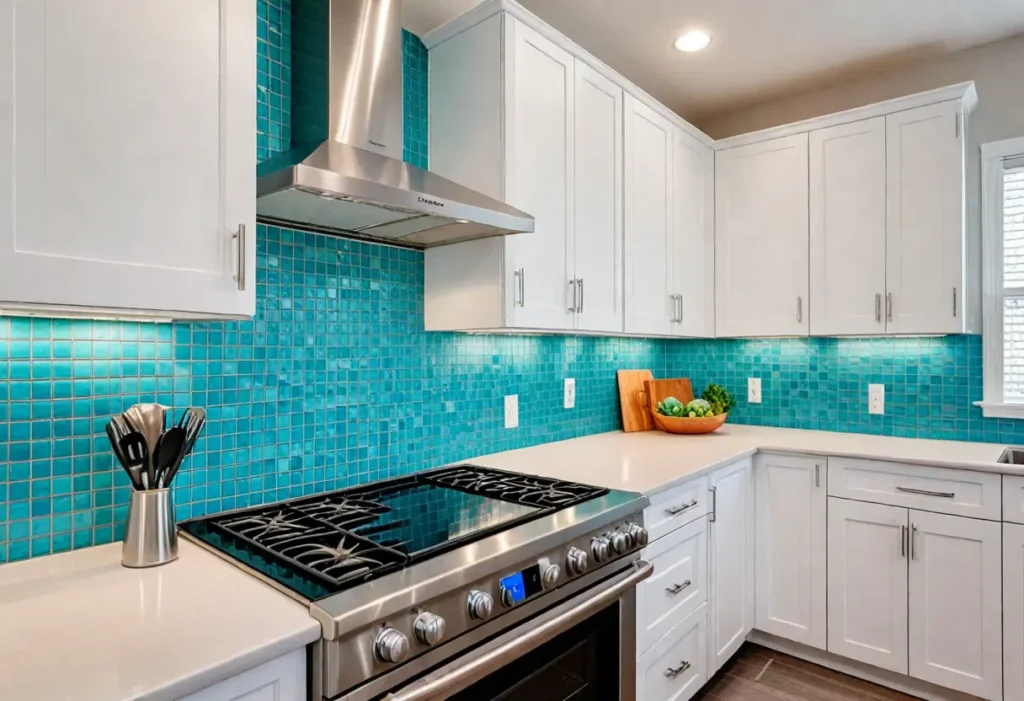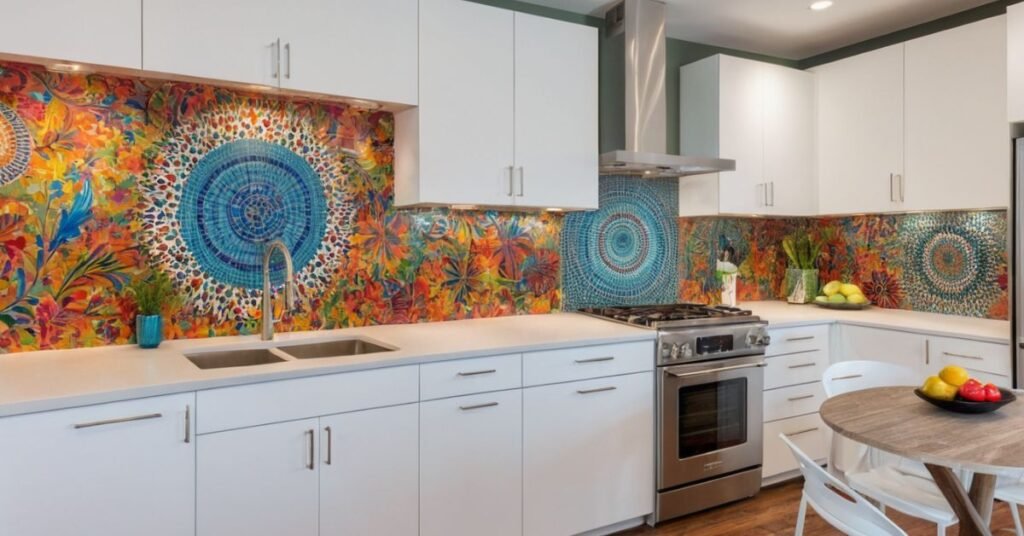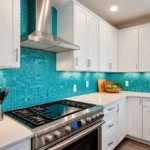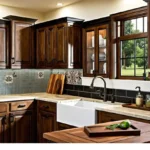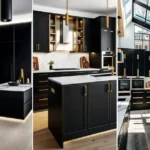In more specific terms, regarding the world of kitchens and their design, back splashes have a dual purpose; the aesthetic and the practical. Although they can guard the walls from such things as spills and even splashes, they create an ideal chance to give character and flavor to any kitchen. Lighting is one of the most efficient ways to make significant changes to the appearance of your backsplash. To truly transform the look, consider how you can highlight your kitchen backsplash with lighting.
This approach not only enhances the visual appeal but also adds a touch of elegance to your space. The relationship between light and surfaces is by far one of the most effective strategies to alter your kitchen, adding a visual element to engage the people’s attention. Significantly, this article aims at elaborating methods of employing lighting to highlight backsplashes and make the kitchen a more appealing place.
The Importance of Backsplash Lighting
Every corner of the interior is important, but especially in the kitchen, where the light serves the purpose of illuminating the space and giving it its character. Lighting is important in that it provides the necessary amount of light intensity for normal operations like cutting vegetables, preparing meals, or washing the dishes etc. As with most interior focal points, light draws attention to the delicate carving and the pattern, as well as the pigments and grain, on backsplashes. In this tutorial you’ll learn how to install lighting into your backsplash and hence create aesthetics to your kitchen while at the same time making the most out of it.
Types of Lighting for Backsplashes
Before diving into creative ideas, it’s important to understand the different types of lighting that can be used to highlight backsplashes:
- Under-Cabinet Lighting: This type of lighting is installed underneath kitchen cabinets, casting light directly onto the backsplash. It is ideal for task lighting and can also be used to create a warm, ambient glow.
- LED Strip Lights: LED strip lights are flexible and can be installed along the edges of the backsplash. They come in various colors and can be adjusted to create different lighting effects.
- Recessed Lighting: Recessed lights are installed into the ceiling and can be directed towards the backsplash. They provide focused illumination and can highlight specific areas of the backsplash.
- Puck Lights: Puck lights are small, round lights that can be mounted under cabinets or on the ceiling. They provide concentrated lighting and are ideal for highlighting specific backsplash features.
- Pendant Lights: Pendant lights hang from the ceiling and can be positioned to shine directly on the backsplash. They come in various styles and can add a decorative element to your kitchen.
Creative Ways to Highlight Backsplashes with Lighting
Now that we’ve covered all the different types of lighting available, let’s look at some creative ways to use them to highlight your kitchen backsplash:
1. Layered Lighting

This type of lighting incorporates working, accent, background and artwork lighting in a manner that may look complex, but has an artistic application. For instance, you can install under cabinet lights for task lighting, and then install the LED strip lights right at the edges of the backsplash to give a warm and a soft brilliance. They are suitable to be installed in a low direction so that they can illuminate portions of backsplash, for instance, a mosaic or special tile design. By layering different light sources, you can create depth and dimension in your kitchen.
Implementation Tips:
- Under-Cabinet Lighting: Install LED strips or puck lights under the cabinets. Ensure they are placed at the front edge to provide even light coverage across the backsplash.
- Recessed Lighting: Position recessed lights in the ceiling or beneath upper cabinets to focus light on key areas of the backsplash.
- LED Strip Lights: Place LED strips along the top and bottom edges of the backsplash for a balanced glow. Use color-changing LEDs for added versatility.
2. Highlighting Texture

In choosing the kind of light to be installed in the backsplash area, consider that if your backsplash has rough materials such as stone, brick or the embossed tiles, these must be highlighted with light. Wash appendages or include LED strip lights or recessed lights that are angled in such a way that can place neat shadows and highlights on the subject, altogether adding dimension. This technique is suitable for natural wood and other organic motifs adding a rather elegant note into your kitchen.
Implementation Tips:
- Angle Lighting: Install lights at a 45-degree angle to cast dramatic shadows and highlights on textured surfaces.
- Wall Grazing: Use recessed lights positioned close to the wall to graze the surface, emphasizing textures and patterns.
3. Color Accents

LED strip lights come in several colors and affording users an opportunity to always change the color to match that of the backsplash. This is suitable in creating a modern outlook and a playful feel in the house when colored LED lights are used to create this interest. It means that by using a remote it is possible to switch the color of the lights to compliance with the seasons, holidays, or simply the mood. For instance, a cool blue lighting provides the atmosphere that helps to relax you, while a light blue backsplash in the kitchen adds a serene touch to the space. On the other hand, warm yellow lighting creates an environment that’s most suitable for cooking.
Implementation Tips:
- RGB LEDs: Use RGB LED strips for customizable color options. Control the color and brightness with a remote or smartphone app.
- Themed Lighting: Change the light colors to match holidays or special occasions. For example, use red and green for Christmas or orange and purple for Halloween. A light green backsplash in the kitchen can also enhance the festive atmosphere, adding a refreshing touch to your seasonal decor.
4. Backlit Backsplashes

Backlighting is perhaps the most effective way of making the backsplash stand out. This entails fixing LED panels or strips behind a back splash that is translucent or semi-transparent for instance glass or onyx. When electricity is passed to the backsplash, they light up creating quite an interesting view to behold. For instance, the backsplashes which are backlit are even more effective when incorporated with material that has one special texture or color since the lighting draws attention to the designs creating a center of attraction in the kitchen.
Implementation Tips:
- Translucent Materials: Choose materials like glass, onyx, or frosted acrylic for the backsplash.
- Even Lighting: Use LED panels or evenly spaced LED strips to avoid hot spots and ensure a uniform glow.
5. Task Lighting for Specific Areas

Besides overall lighting on the backsplash you can apply accent lighting on the areas of the backsplash kitchen that you want to make emphasize. For instance, if you have a decorated tile mural or an artistic corner that serves a decorations element, you can directly install the puck lights or the small spotlights. This produces an eye-catching effect on the feature that you have added and it brings an aspect of elegance to your kitchen.
Implementation Tips:
- Spotlights: Use adjustable spotlights or puck lights to focus on specific areas of interest.
- Accent Lighting: Highlight areas with unique patterns, artwork, or custom tiles to draw attention.
6. Under-Cabinet LED Strips

Some of the lighting fixations that are most commonly used for backsplash illumination include the under-cabinet LED strips. They give out even, consistent light that floods the whole backsplash and adds to its visibility to the optimum level. LED strips can be dimmable, therefore there is a way you can be able to change the brightness to fit the mood that you want. It is also an energy efficient and durable set thus suitable to be incorporated into any kitchen.
Implementation Tips:
- Easy Installation: Choose adhesive-backed LED strips for easy installation under cabinets.
- Dimmable Options: Opt for dimmable LED strips to adjust brightness levels for different tasks and moods.
7. Pendant Lights with a Twist

Island light fixtures are suspended to diffuse light over the counter area, but these can also be installed that targets the backsplash area. Select pendant lights with swiveling heads so that you can angle the light source to the position of its usage, such as reading or work. In addition, one may go for pendant lights with installed colored or texturized shades that harmonize with the backsplash material. This gives an ornamental aspect to the lighting deployment and provides a harmony in the look of your kitchen.
Implementation Tips:
- Adjustable Heads: Select pendant lights with adjustable heads to direct light onto the backsplash.
- Decorative Shades: Choose pendant lights with shades that complement the backsplash material and color scheme.
8. Smart Lighting Solutions

They enable the users to manage the lighting in their kitchen from a smartphone or verbal commands. It may be applied for the purpose of creating themes and requirements of the illuminations for various events. For instance, you can switch lights to a white base for kitchens or strong yellow tones for dining room but a bright color for parties. Smart lighting also can also be set on a timer so that it changes its settings periodically, spotlighting your kitchen and the backsplash at preferred times.
Implementation Tips:
- Smart Bulbs: Use smart LED bulbs or strips that can be controlled via a smartphone app or voice assistant.
- Custom Scenes: Create custom lighting scenes for different activities, such as cooking, dining, or entertaining.
9. Lighted Shelves

Install lighted shelves near your backsplash area, either on top of that or as a part of it. These shelves can serve dual purposes: To offer cabinets or shelves for storage or display and light the back area most of the time. Installing shelves with lightings around the shelves will make the kitchen decor to have a needed and sleek appearance and also show off the backsplash and other items placed in the shelves.
Implementation Tips:
- LED Strips: Install LED strips along the underside of the shelves for consistent illumination.
- Display Items: Use the shelves to display decorative items or kitchen essentials, adding both function and style.
10. In-Cabinet Lighting

If, for example, you have glass-front cabinets above your backsplash, think about installing cabinetry lighting. This will not only brighten the contents of these cabinets but also provided some light on the backsplash which adds depth of the light that can be used in kitchens.
Implementation Tips:
- Glass Cabinets: Install LED puck lights or strip lights inside glass-front cabinets.
- Reflective Surfaces: Use reflective or glossy backsplash materials to maximize the light effect.
11. Toe-Kick Lighting

Place LED strips on the toe-kick zone, which is the base cabinet kicked space underneath the lower portion of the cabinets. This effect as seen in the picture above can add an element of elegance, surprise and contemporary edge while also lighting up the backsplash from below, giving the cabinets on the wall a ‘floating effect’ and enhancing the overall mood of the room.
Implementation Tips:
- LED Strips: Choose waterproof and durable LED strips designed for toe-kick installation.
- Ambient Glow: Use toe-kick lighting in combination with other light sources to create a comprehensive lighting scheme.
12. Lighted Range Hood

Combine the lighting of your range hood with the accent lighting of your surrounds to light up your backsplash. When choosing a modern range hood, it is not uncommon to find that some are equipped with lights that can be pointed towards the backsplash. This method is useful for ensuring the backsplash has enough light, especially the part behind the cooking zone.
Implementation Tips:
- Built-In Lights: Choose a range hood with built-in lighting that can be directed onto the backsplash.
- Task Lighting: Use the range hood lighting as task lighting while cooking, and as accent lighting when not in use.
Practical Considerations
While creative lighting can transform your kitchen, it’s important to consider practical aspects to ensure the best results:
- Brightness: Ensure that the lighting is bright enough for tasks but not so bright that it creates glare or discomfort. Dimmable lights offer flexibility to adjust brightness as needed.
- Placement: Carefully plan the placement of lights to avoid shadows and ensure even illumination. Consider the height of cabinets, the size of the backsplash, and the layout of the kitchen.
- Color Temperature: The color temperature of the lights affects the ambiance of the kitchen. Warm white lights (2700K-3000K) create a cozy atmosphere, while cool white lights (4000K-5000K) provide a more modern and vibrant look.
- Energy Efficiency: Choose energy-efficient lighting options such as LEDs to reduce energy consumption and lower electricity bills. LEDs also have a longer lifespan compared to traditional bulbs.
- Safety: Ensure that all lighting fixtures and installations comply with safety standards. Avoid placing lights near water sources and use waterproof fixtures for areas prone to splashes.
Conclusion
Effective lighting of the kitchen backsplash can give flair to the overall outlook of your kitchen area where you can freely cook and prepare food. Having ascertained the possible kinds of lightings, you also can look for ways of how they can enhance the distinctive character of the backsplash and become the undeniable focus. Depending on whether you want your kitchen lighting to be discrete and elegant or bright and flashy there are literally hundreds of ways to light up your kitchen to optimum advantage. Make time to try different lighting arrangements, and you will transform your kitchen into an attractive work of art, as well as a pleasure to both cook and host a meal.

